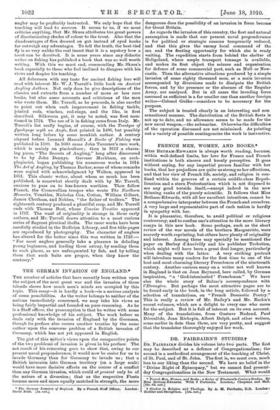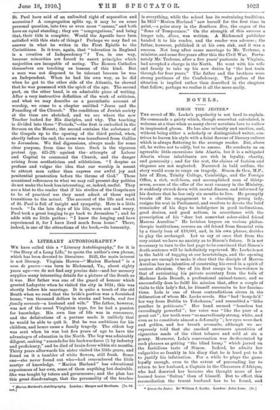DR. FAIRBAIRN'S STUDIES.t
Du. FAIRBAIRN divides his volume into two parts. The first may be described as a defence of Congregationalism; the second is a methodical arrangement of the teaching of Chzist, of St. Paul, and of St. John. Thefirst is, we must own, much less to our liking than the second. We have no belief in the "Divine Right of Episcopacy," but we cannot find present- day Congregationalism in the New Testament. What would • French Men, Women, and Books i a Series of Nineteenth-Century Studies. By Mina Betham-Edwards. With 8 Portraits. London,: Chapman and HalL [10s. 6d. net.] t Studies in Religion and Theology. By Ai M. rairbairn, D.D. London; Hodder and Stoughton. [12s. net St. Paul have said of an unlimited right of separation and secession ? A congregation splits up, it may be on some personal question, into two or even more " causes," and both have an equal standing ; they are " congregations," and being that, their title is complete. Would the Apostle have been satisfied with this state of things ? Perhaps we may find an answer in what he writes in the First Epistle to the Corinthians. Is it true, again, that " toleration in England is a creation of Independency " Yes, in one way, because minorities are forced to assert principles which majorities are incapable of seeing. The Roman Catholics themselves are teaching us lessons of this kind. But a man was not disposed to be tolerant because he was an Independent. When he had his own way, as he did when he got to the other aide of the Atlantic, he showed that he was possessed with the spirit of the age. The second part, on the other hand, is an admirable piece of writing. After a very instructive definition of the work of criticism, and what we may describe as a parenthetic account of worship, we come to a chapter entitled " Jesus and the Founding of the Church." The conditions of Jewish society at the time are sketched, and we see where the new Teacher looked for His disciples, and why. The teaching is divided into three "Periods,"—the first is embodied in the Sermon on the Mount; the second contains the substance of the Gospels up to the opening of the third period, when, shortly before the end, the scene was transferred from Galilee to Jerusalem. We find digressions, always made for some clear purpose, from time to time. Such is the vigorous protest (pp. 425-28) - against the- attempts of Labour and Capital to command the Church, and the danger arising from aestheticism and athleticism. " I despise as profane and vulgar the idea that our worship is meant to attract men rather than express our awful joy and penitential prostration before the throne of God." These occasional references to what we may call present-day politics do not make the book less interesting, or, indeed, useful. They are a hint to the reader that if his studies of the Gospels are to be of practical use they must admit of these rapid transitions to the actual. The account of the life and work of St. Paul is fall of insight and sympathy. Here is a little touch. " In the late days of his life, worn out and weary, Paul took a great longing to go back to Jerusalem " ; and he adds with no little pathos : " I know the longing and have experienced it, for I have lived much from home." There, indeed, is one of the attractions of the book, its humanity.











































 Previous page
Previous page